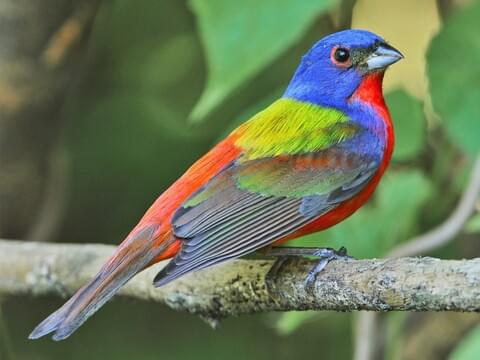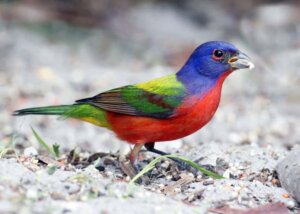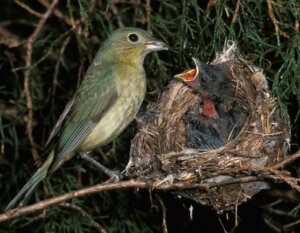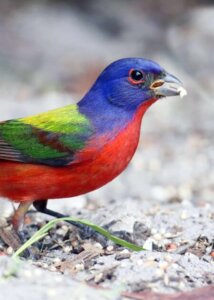Are Painted Buntings Rare: Discover the Truth
Yes, painted buntings are considered rare. These colorful birds are a sight to behold, but spotting one can be a challenge.
Painted buntings, with their vibrant plumage, often leave birdwatchers in awe. Known for their elusive nature, these birds are not commonly seen. They primarily inhabit dense thickets and shrubby areas, making them hard to spot. Their population faces threats from habitat loss and illegal trapping.
This adds to their rarity. Understanding their habits and habitats can help bird enthusiasts better appreciate and possibly encounter these stunning birds. Painted buntings remind us of the delicate balance in nature and the importance of preserving their habitats for future generations.
Introduction To Painted Buntings
Painted Buntings are small, vibrant birds. Their colorful feathers catch the eye. Many people admire their beauty. But, are Painted Buntings rare? Let’s explore.
Bird’s Appearance
Male Painted Buntings are known for their bright colors. They have blue heads, red underparts, and green backs. Females and young birds are greenish-yellow. This helps them blend into their surroundings.
Geographic Range
Painted Buntings live in parts of North America. They are often found in the southeastern United States. During winter, they migrate to Central America. They also visit some Caribbean islands.

Credit: www.midtownmag.com
Habitat And Behavior
Painted Buntings are a colorful sight to behold. These birds captivate many with their vivid plumage and intriguing behavior. Understanding their habitat and behavior gives insights into their rarity and charm.
Preferred Environments
Painted Buntings thrive in specific habitats. They prefer dense, shrubby areas. You can find them in thickets, brushy fields, and woodland edges. In the southeastern United States, they often inhabit coastal areas. They also enjoy habitats with plenty of cover. This helps them hide from predators. They also like environments with abundant food sources. Seeds, insects, and berries make up their diet.
Breeding Habits
The breeding season for Painted Buntings is fascinating. Males arrive first to set up territories. They sing to attract females and ward off rivals. Their bright colors help in this display. Nests are built in dense shrubs or low trees. Females take charge of nest building. They use grass, leaves, and other plant materials. Clutches typically have three to four eggs. The incubation period lasts about 11 to 12 days. The young leave the nest about two weeks after hatching. Both parents care for the fledglings.
Population Status
Painted Buntings are one of the most colorful birds in North America. Bird enthusiasts often wonder about their population status. Understanding their current numbers and historical trends can provide insights into their rarity. This section delves into these aspects, offering a clearer picture of the Painted Bunting’s existence.
Current Numbers
The current population of Painted Buntings is estimated to be around 4.5 million. These birds are primarily found in the southeastern United States. They also inhabit parts of Mexico and Central America during migration. Despite their striking appearance, they can be elusive. This makes them seem rarer than they actually are.
Historical Trends
The Painted Bunting population has seen fluctuations over the years. In the past, their numbers were higher. Habitat loss and illegal trapping have impacted their population. Conservation efforts have helped stabilize their numbers recently. Still, their colorful plumage makes them targets for the pet trade. Monitoring and protection are crucial to ensure their survival.

Credit: www.nytimes.com
Threats To Painted Buntings
The Painted Bunting is a beautiful bird with vibrant colors. It is often sought after by bird watchers and nature lovers alike. Sadly, these stunning birds face several threats that endanger their survival.
Habitat Loss
Habitat loss is one of the main threats to Painted Buntings. They thrive in dense, shrubby areas and woodland edges. Sadly, urbanization and deforestation are destroying their natural habitats.
Here are some key points about habitat loss:
- Urban development removes essential vegetation.
- Agricultural expansion reduces available nesting areas.
- Logging operations clear out vital forested regions.
Climate Change Impact
Climate change significantly affects Painted Buntings. Shifts in temperature and weather patterns disrupt their breeding and migration.
Consider the following impacts of climate change:
- Altered migration patterns affect their feeding and breeding cycles.
- Changing temperatures impact their food sources.
- Extreme weather events can destroy nests and habitats.
Both habitat loss and climate change pose serious threats to Painted Buntings. Conservation efforts are essential to protect these beautiful birds.
Conservation Efforts
Painted Buntings, with their bright colors, are a sight to behold. Sadly, these birds are becoming rare. Conservation efforts play a crucial role in protecting them. These efforts involve various strategies to ensure their survival.
Protection Programs
Many organizations have established protection programs for Painted Buntings. These programs focus on habitat preservation. They aim to maintain and restore natural environments. By doing so, they provide safe spaces for these birds to thrive.
Another aspect of these programs is monitoring. Experts track bird populations to understand their numbers. This data helps in making informed conservation decisions. It also highlights areas needing urgent attention.
Community Involvement
Community involvement is essential in conservation efforts. Local communities can help by creating bird-friendly environments. Planting native trees and shrubs can provide necessary shelter and food for Painted Buntings.
Educating the public is also vital. Awareness campaigns can inform people about the importance of these birds. They can learn how to contribute to their protection. Simple actions, like reducing pesticide use, can make a big difference.
Volunteering is another way communities can help. Many organizations offer volunteer opportunities. People can participate in bird counts and habitat restoration projects. Their efforts can directly impact the survival of Painted Buntings.

Credit: www.allaboutbirds.org
How To Spot Painted Buntings
Spotting a Painted Bunting can feel like finding a rare gem. These birds are known for their vibrant colors and elusive nature. By knowing where to look and what to do, you can increase your chances of seeing one.
Best Locations
Painted Buntings are often found in the southeastern United States. They prefer habitats with dense shrubbery and thickets. Look for them in coastal areas, brushy fields, and woodland edges. During the breeding season, they are more common in the southeastern coastal plains. In winter, they migrate to southern Florida, the Caribbean, and parts of Central America.
Birdwatching Tips
Use binoculars to spot these colorful birds from a distance. They are often shy and can be hard to see up close. Early morning is the best time to observe them, as they are most active then. Learn their songs and calls. Painted Buntings have a distinctive, high-pitched song that can help you locate them. Be patient and move slowly. Sudden movements can scare them away. Wear muted colors to blend into the environment. Bright clothes can startle birds.
Frequently Asked Questions
What Makes Painted Buntings Rare?
Painted Buntings are rare due to their limited breeding range and habitat loss. They are mostly found in the southeastern United States. Their vibrant colors also make them a target for illegal pet trade.
Where Can You Find Painted Buntings?
Painted Buntings are typically found in the southeastern United States. They prefer habitats like coastal thickets, brushy areas, and woodland edges. Spotting them can be challenging due to their elusive nature.
When Is The Best Time To See Painted Buntings?
The best time to see Painted Buntings is during their breeding season, from May to July. During this time, they are more active and visible.
Why Are Painted Buntings Colorful?
Painted Buntings are colorful to attract mates and deter predators. Males display vibrant colors, while females are more subdued. This helps in camouflage and survival.
Conclusion
Painted Buntings are indeed rare and fascinating birds. Their vibrant colors make them special. Spotting one feels like finding a treasure in nature. They are mostly found in the southeastern United States. Protecting their habitats is crucial for their survival.
Birdwatchers cherish sightings of Painted Buntings. These birds remind us of nature’s beauty. Learning about them can spark a deeper appreciation for wildlife. So, keep an eye out and enjoy the wonder of Painted Buntings. Respect and preserve their delicate environments for future generations.
Hello Dear, I'm Poli Kolymnia, owner of many birds (including budgies).
With a deep passion for these feathered companions, I'm here to share my expertise and extensive knowledge on birds care.
My articles cover essential topics like diet, housing, care, and health, providing practical tips to help you create a happy and thriving environment for your birds.



